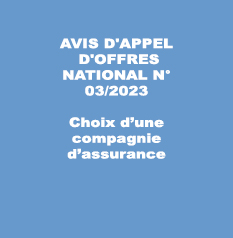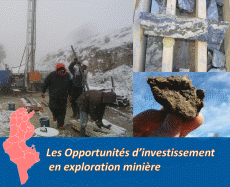| Programme annuel & rapport de suivi technique |
-

Rapport d'activités 2023
-

Programmes Techniques 2024
|
| Géocatalogue |

|
| Appels d'Offres |
-

ACQUISITION DES TICKETS RESTAURANT POUR LE PERSONNEL DE L’ONM
-

CHOIX D’UNE COMPAGNIE D’ASSURANCE
-

ACQUISITION ET MISE EN ŒUVRE D’UN PROGICIEL DE GESTION INTEGRE
|
|
Investir en Tunisie |


|
|
|
|
|
::
Documentation and Editions
>>
Research library
|
| |
|
[
Search by author
]
[
Search keyword
]
[
Search by index
]
[
Search by category
]
|
title of the reference :
|
Oil and source rock geochemistry and exploration implications in Northen Tunisia.
|
|
Publication Date:
|
1995
|
|
Author :
|
Hughes W.B., Reed J.D., ARCO
|
|
Catalogue type :
|
Livre
|
|
Catalogue reference :
|
Oil and source rock geochemistry and exploration implications in Northen Tunisia. Detailed geochemical analysis of produced crude oils, seeps and oils-stained cores from reservoirs/outcrops of Cretacious and Tertiary age and extracts of potential source formations resulted in the identification of three families of oils which could be correlated to specific source rocks. Family 1 contains oils from the offshore Gulf of Gabes, Guebiba, Gremda, Mahres and El Hajeb fields: the onshore Gulf of Hammemet Tierf field and an oilstrained outcrop from Djebel Debedib. These oils occur in Cretaceous (Aptian-Maastrichtian) reservoirs, exepting the oil stain from the Oligocene Fortuna formation are derived from the Cenomanien/Turonien Bahloul formation. Family 2 contains oils from the Douleb, Semmama and Tamesmida fields, the BEG-1 well, the onshore Gulf of Hammamet Cap Bon field, and an oil-stained outcrop from Djebel Serj. These oils occur in Cretaceous (Aptian-Cenomanian)reservoir and derived from the Aptien Mouelha formation. Family 3 contains the offshore Gulf of Gabes oils and occurs in Tertiary (Eocene) reservoirs. The source of these oils is the Eocene Bou Dabbous formation. Two oils appear to be mixtures : oil from the Eocene Metlaoui formation in the Sidi El Etayem field is mixture of Family 1 and Family 3 oils and Djebel Bou Dabbous seep from the Campanian-Maastrichtian Abiod formation appears to be a mixture of family 1 and Family 2 oils. A common Bou Dabbous (Eocene) source for the offshore oils in this study implies the absence of a Cretaceous-based petroleum system or the presence of an effective seal which prevents Cretaceous derived oils reaching Tertiary reservoirs in the Gulf of Gabes. The occurrence of Cretaceous-derived oils immediately onshore suggests the latter possibility is the case and makes pre-Tertiary reservoirs attractive targets in the offshore.
MEMOIR n°9 - ETAP
pétrole ; Crétacé ; Tertiaire ; carbone organique ; matière organique ; corrélation ; stérane ; diastérane ; biomarqueur ; phytane ; pristane ; lithostratigraphie ; Tunisie ; Golfe de Gabès ; Gremda ; El Hajeb ; Golfe de Hammemet ; J. Debadib Reed J.D. ARCO Hughes W.B. Géochimie
|
|
Indexation decimale :
|
Géochimie
|
|
Keywords :
|
pétrole ; Crétacé ; Tertiaire ; carbone organique ; matière organique ; corrélation ; stérane ; diastérane ; biomarqueur ; phytane ; pristane ; lithostratigraphie ; Tunisie ; Golfe de Gabès ; Gremda ; El Hajeb ; Golfe de Hammemet ; J. Debadib
|
|
Summary :
|
Detailed geochemical analysis of produced crude oils, seeps and oils-stained cores from reservoirs/outcrops of Cretacious and Tertiary age and extracts of potential source formations resulted in the identification of three families of oils which could be correlated to specific source rocks. Family 1 contains oils from the offshore Gulf of Gabes, Guebiba, Gremda, Mahres and El Hajeb fields: the onshore Gulf of Hammemet Tierf field and an oilstrained outcrop from Djebel Debedib. These oils occur in Cretaceous (Aptian-Maastrichtian) reservoirs, exepting the oil stain from the Oligocene Fortuna formation are derived from the Cenomanien/Turonien Bahloul formation. Family 2 contains oils from the Douleb, Semmama and Tamesmida fields, the BEG-1 well, the onshore Gulf of Hammamet Cap Bon field, and an oil-stained outcrop from Djebel Serj. These oils occur in Cretaceous (Aptian-Cenomanian)reservoir and derived from the Aptien Mouelha formation. Family 3 contains the offshore Gulf of Gabes oils and occurs in Tertiary (Eocene) reservoirs. The source of these oils is the Eocene Bou Dabbous formation. Two oils appear to be mixtures : oil from the Eocene Metlaoui formation in the Sidi El Etayem field is mixture of Family 1 and Family 3 oils and Djebel Bou Dabbous seep from the Campanian-Maastrichtian Abiod formation appears to be a mixture of family 1 and Family 2 oils. A common Bou Dabbous (Eocene) source for the offshore oils in this study implies the absence of a Cretaceous-based petroleum system or the presence of an effective seal which prevents Cretaceous derived oils reaching Tertiary reservoirs in the Gulf of Gabes. The occurrence of Cretaceous-derived oils immediately onshore suggests the latter possibility is the case and makes pre-Tertiary reservoirs attractive targets in the offshore.
|
|
Exemplaries :
|
-
|
|
|
|
|
|
|
|



